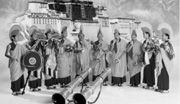THE LAST TWO appearances by the Tibetan Lamas from the Drepung Loseling monastery last weekend at the Kirkland Performing Arts Center was a fascinating combination of ancient and modern, the spiritual and the mundane. Sixteen months into an 18-month tour of 150 cities, the monks appearing in “The Mystical Arts of Tibet: Sacred Music, Sacred Dance” might be seen as refugees from their own exiled monastery in southern India. They embarked on this extended trip in order to raise awareness of Tibet, to heal the environment, and, quite frankly, to raise money to support their home in India. And while it might seem odd to watch a spiritual rite performed in a theater, the monks contend the ultimate Tantric view is that all places are equally sacred.
The Mystical Arts of Tibet: Sacred Music, Sacred Dance
Kentwood High School, Kent October 7
Probably best known for their unique vocal skills, the monks sing two or three notes simultaneously, creating a spine-tingling buzzing that combines with bells, drums, and distinctive long-horn notes in a repetitive cacophony. The dancing that accompanies this sound is deceptively relaxed—pacing and hopping on simple pathways with easy, looping gestures. In dances believed to eliminate negative energies and placate the spirits of the dead, the monks embody a calm vitality. Their physicality is reminiscent of Native American ceremonial dancing, in which the performers maintain a low-key, long-term energy; they focus their movements as a group rather than for the audience.
THE PROGRAM includes music, dance, and dialogue—an example of teaching through inquiry in which one monk questions a student. The exchange grew to resemble a baseball game, with the interlocutor literally pitching his questions with a slapping action and the “fans” answering with rhythmic clapping . Each of the monks’ residencies includes the creation of a sand mandala, an intricate design with complex symbolic meaning. The building of the mandala is a meditative act, and the deliberate, precise movements of its construction are a dance in themselves. The monks spread the sand with long metal funnels, adding layers of detail until the surface of the work resembles a miniature landscape with hills and valleys.
They complete the ceremony by destroying the mandala, first drawing lines through it and then mixing the multicolored images together. They pour some of the sand into vials for us to take away, and the rest is gathered into an urn. Since there wasn’t enough room in the Kirkland Performance Center lobby for the audience to observe, in an odd combination of ancient and contemporary practices we watched a ceremony over 500 years old on a closed-circuit, big-screen television.
Finally we left, some of us walking in procession down the hill to Lake Washington with the monks carrying the urn of sand. We stood on the Kirkland public dock in the rain, listening to the rumbling of their multiphonic chanting and watching the sand poured into the lake, carrying their message of universal healing out to the world.








